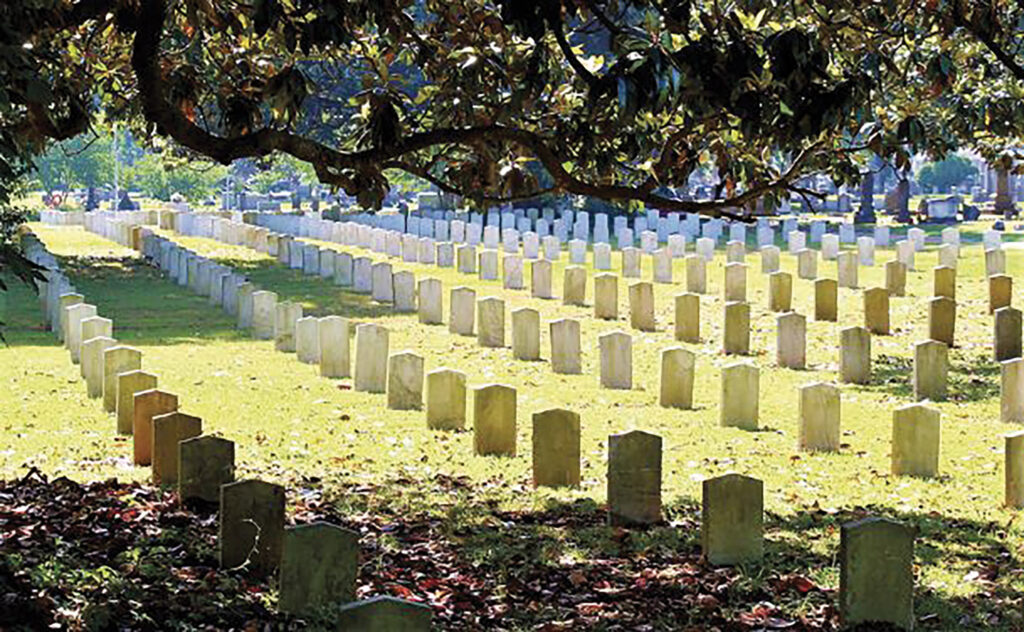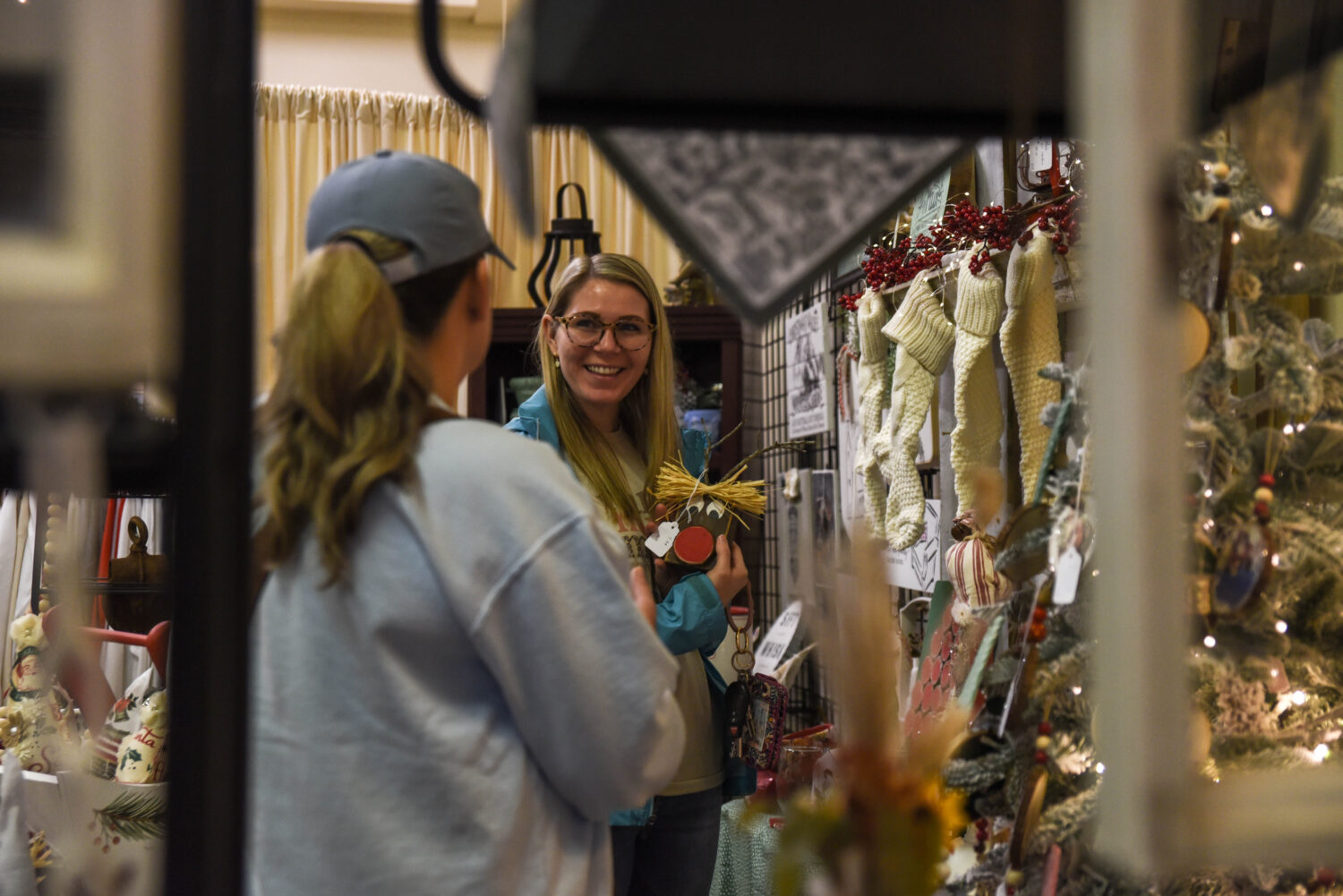
Columbus was not the first place where flowers were placed as a healing act on graves of soldiers. However, it was the actions of the ladies of Columbus whose placing of flowers on both Confederate and Union graves attracted nationwide attention as an example of reconciliation and inspiration.
In Columbus, the decoration of Confederate graves began in 1863. Such decoration days were occurring in many towns. In 1865 there was a ceremony by freed slaves in Charleston, South Carolina, honoring Union soldiers buried there. The Richmond Examiner on March 22, 1866, reported movements had begun “by ladies associations” in Winchester, Virginia; Columbus, Georgia; and across the South to “care for and garland those tombs of the heroic and dear.” In the spring of 1866, ladies in Columbus, Georgia, proposed having a single Decoration Day across the South for the decoration of Confederate graves.
Ladies in Columbus, Mississippi, acted on that proposal and on April 25, there was a decoration ceremony at Friendship Cemetery where graves of soldiers were decorated with flowers. The ceremony at Friendship went a step further than elsewhere, as the ladies decorated not only the graves of more than 2,100 Confederate soldiers buried there but also, in an act of compassion, placed flowers on the graves of at least 40 Union soldiers also buried in the cemetery.
That act of compassion and reconciliation received praise in the national press with extensive coverage of the ladies’ action appearing in papers from Maine to California. Coverage in Horace Greely’s New York Tribune praised the ladies for their “noble sentiments” and inspired the poem “The Blue and the Gray.” In 1868, in Waterloo, New York, Memorial Day began to emerge as a single day of remembrance across the nation to honor our fallen heroes. It was President Lyndon Johnson who declared Waterloo to be the birthplace of Memorial Day. The importance and inspiration of the actions of the ladies of Columbus are shown by a May 9, 1869, article in the Maine Farmer of Augusta, Maine. A year after the ceremony in Waterloo, the Maine paper wrote:
“Two years ago it was stated that the women of Columbus, Mississippi, showed themselves impartial in the offerings which they made to the memory of the dead; for they strewed flowers alike on the graves of the Confederate and national soldiers…Let others emulate this spirit…Thus may the ceremony of Decoration Day become a truly national one.”
This evolution of the creation of Memorial Day was recognized by President Barack Obama in his 2010 Memorial Day Address when he concluded the address by saying:
“On April 25, 1866, about a year after the Civil War ended, a group of women visited a cemetery in Columbus, Mississippi, to place flowers by the graves of Confederate soldiers who had fallen at Shiloh. As they did, they noticed other graves nearby, belonging to Union dead. But no one had come to visit those graves, or place a flower there. So they decided to lay a few stems for those men too, in recognition not of a fallen Confederate or a fallen Union soldier, but a fallen American. A few years later, an organization of Civil War veterans (this was at Waterloo) established what became Memorial Day, selecting a date that coincided with the time when flowers were in bloom. So this weekend, as we commemorate Memorial Day, I ask you to hold all our fallen heroes in your hearts, and if you can, to lay a flower where they have come to rest.”
What inspired the ladies of Columbus to begin the reconciliation of North and South? Augusta Sykes Cox whose husband and brother-in-law both died during the war has traditionally been credited with suggesting Union graves should also be decorated. She wrote a letter to her granddaughter telling the story: “Just after the first decoration of our Confederate soldiers’ graves, I was on a committee with a dear friend, Miss Matt Morton; and we had a large quantity of flowers in excess of what we needed for our own dead. The graves of the Federal soldiers looked so bare and desolate, I said to my friend, ‘Let’s drop a flower on each of their graves for their Mother’s sakes, each mound represents some Mother’s darling.’”
Most people associate Friendship Cemetery with the Civil War but there is so much more history there. However, it is the Civil War period plots of the cemetery that visually grab your attention. There are two plots within the grounds in which there are buried over 2,100 Confederate soldiers who died in or on the way to military hospitals in Columbus. There are also graves of a few Union soldiers not moved in 1867 to Corinth National Cemetery. Within those areas are beautiful huge old magnolia trees. Those trees themselves tell a story.
In 1869 the Ladies Monumental Association was organized at the Methodist Church to erect a monument to the Confederate soldiers buried in Friendship Cemetery and help care for their graves. The original burial plot for Confederate soldiers was in the southwest corner of the cemetery. It quickly filled up after the Battle of Shiloh and a much larger plot opened on the northwest side of the cemetery. In 1869 the Ladies Monumental Association planted magnolias along the lane connecting the two burial plots and it was named Magnolia Avenue.
Recently the large Confederate monument that for more than 100 years stood in front of the Lowndes County Courthouse was cleaned, restored, and moved to the cemetery. It now stands guard over the Confederate graves in the cemetery’s southwest corner. It looks good there and it is interesting to note that originally the United Daughters of the Confederacy did not want the monument at the courthouse.
The cemetery is an old cemetery, having been established by the Odd Fellows in 1849 and is a beautiful setting for a walk through history going back to America’s founding. The monuments there present a visual image of the past while those who rest there range from William Cocke, Tennessee’s first U.S. Senator and friend of Thomas Jefferson, to Josh Meador, Walt Disney’s Oscar winning head of animation effects, to Clyde Kilby, J.R.R. Tolkien’s last editor, to A.B. Meek, a nationally prominent 19th century Alabama author, attorney, and political figure. Also buried at Friendship are two governors, several Civil War generals, Agustus Jones, who froze to death when the ill-fated steamer Eliza Battle caught fire and burned on a freezing, flooded Tombigbee River and Rev. Thomas Teasdale whose grave is marked by a very poignant crying angel.
Many of the stories held by Friendship Cemetery are told each spring in MSMS’s Tales From the Crypt. If you haven’t attended one of those performances, you have missed a treat.
In the midst of holiday barbecues and events, we must not forget the real meaning of Memorial Day. It began as a day to honor those who sacrificed their lives ensuring that we remain a free people. We should never forget their sacrifice and as President Obama said, “Hold all our fallen heroes in your hearts, and if you can, to lay a flower where they have come to rest.”
Rufus Ward is a Columbus native a local historian. E-mail your questions about local history to Rufus at [email protected].
You can help your community
Quality, in-depth journalism is essential to a healthy community. The Dispatch brings you the most complete reporting and insightful commentary in the Golden Triangle, but we need your help to continue our efforts. In the past week, our reporters have posted 41 articles to cdispatch.com. Please consider subscribing to our website for only $2.30 per week to help support local journalism and our community.






